Overfeeding can result in water quality changes and pathogens
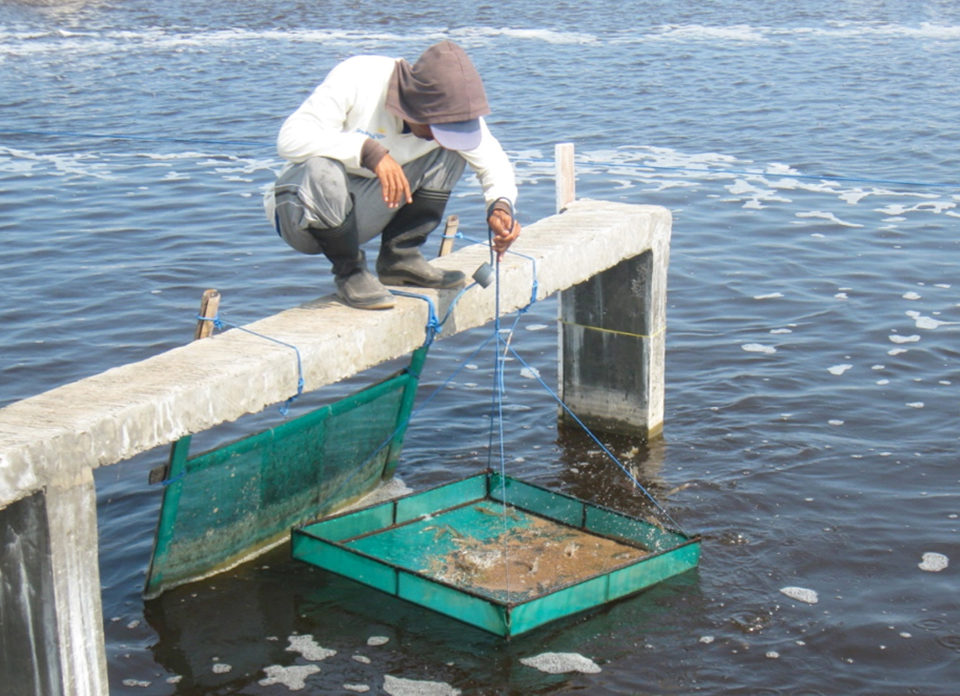
About 50 percent of the operational cost of shrimp farming comes from the aquafeed used. Feed management faces several huge challenges. The shrimp feed sinks to pond bottoms, and feeding adequacy cannot be visually monitored like in fish feeding. Feed requirements change daily because of weather conditions and water quality fluctuations.
Because of high density in a small volume of water, overfeeding can quickly overload pond ecosystems, resulting in changes in water quality and blooming of opportunistic microbiota, some of which can be pathogenic. A better understanding of shrimp-feeding management can avoid these problems and greatly improve the bottom line.
Feed quality
Not all feeds are created equal. Some feeds have better digestibility, amino acid profiles and fatty acid profiles, and contain sufficient immune stimulants. Selecting a consistently good-quality feed will result in better average daily growth, survival and feed conversion, and thereby a better bottom line.
Tray-based feed programing
Feeding guides developed by a feed mill or individual farmer are based on many trials and errors. In the first 25 to 30 days after stocking the postlarvae, the feeding program is called blind feeding. The daily feed volume given to the postlarvae is deliberately programed to be excessive. Much of the feed actually goes to fertilize the pond water and enters the food web in the pond ecosystem to end up mainly in the shrimp.
During this early stage, the postlarvae prefer natural feed. It is not until 22 to 25 days after stocking that the juvenile shrimp begin to take the commercial feed. Better-quality postlarvae grow faster and begin to consume the feed earlier.
Several weeks after stocking, feed trays should be used to monitor whether the feed amount is correct. This measure is very important in intensive shrimp farming, because water quality can change abruptly, affected by weather conditions and feed input. Through meticulously monitoring the feed trays, farmers can detect a slowdown in feeding and adjust the feed amount, thus enhancing shrimp health.
A 90-cm-wide by 120-cm-high water barrier positioned 15 to 30 cm upstream of the feed tray can ensure that no feed is swept away by strong currents from aerators.
Water quality
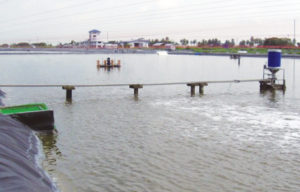
“To culture shrimp, one must first cultivate the water” is the adage of many shrimp farmers in Asia. As shrimp are reared in a small space with a small volume of water to maximize profit, the shrimp excretions, uneaten feed and myriad opportunistic micro-biota growing in it put tremendous strain on pond ecosystems. Any inputs to the systems can greatly affect the water quality in the small volume of pond water, as ponds are the “kitchens” as well as the “toilets” of the shrimp. Shrimp farmers must always take a holistic approach in managing ponds, keeping particularly close watch on water quality and pond bottom hygiene.
Two of the major parameters that greatly influence shrimp health are ammonia and hydrogen sulfide levels. The presence of ammonia and hydrogen sulfide quickly escalates if there is overfeeding. Ammonia, the by-product of protein degradation, becomes noxious at pH higher than 8.5. Uneaten feed, shrimp feces and dead microbiota become hydrogen sulfide in anaerobic areas of pond bottoms. Hydrogen sulfide becomes toxic at a pH of 6.5 and high temperature.
In intensive shrimp ponds with little water exchange or low salinity, minerals such as magnesium, potassium and calcium can become deficient due to direct uptake by the shrimp from the water. These have to be periodically monitored to ensure optimal levels.
Bottom quality, sludge removal
If feeding and water quality are not managed well, sunken shrimp feces, uneaten feed and dead microbiota accumulate in areas of stagnant water and become sludge. Pathogenic bacteria grow profusely on the nutrient-rich sludge. When further shrimp feed sinks onto these areas, it is contaminated by the pathogenic bacteria and, if eaten by the shrimp, can result in disease.
Pond bottoms should be periodically monitored by farmers, especially in semi-intensive systems where the number of aerators used is low. The sludge areas can be marked by poles so they do not receive feed. In intensive systems, the aerators normally sweep the sludge into a stagnant area, where the sludge can be periodically discharged. Some farmers even siphon the sludge periodically.
Auto-feeders
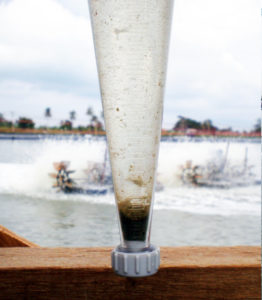
The first use of auto-feeders in shrimp feeding was revolutionary. In the past, it was thought that feed must be spread evenly in a pond so that all shrimp can feed optimally. But with auto-feeders, the shrimp learn to come to the feeders when they are hungry.
An auto-feeder disseminates small quantities of feed intermittently in minutes. Much of the feed is caught by the shrimp before it sinks to the pond bottom. The feed does not have time to lose its nutrients or pick up pathogenic bacteria from the pond bottom.
The author has tried using an auto-feeder, which spread feed over an area of only 300 m<sup>2</sup> in a pond of 8,000 m<sup>2</sup>. The growth, survival and feed conversion achieved were better than when the conventional method of spreading feed all over the pond was used.
Fasting
Fasting or interrupted feeding is a useful practice that not only allows the scavenging Pacific white shrimp (Litopenaeus vannamei) to clean up remaining organic matter on pond bottoms, but also allows the microbiota to catch up on consuming the rich nutrients in the water. Both actions produce cleaner pond bottoms and better water quality. It is a good practice to carry out occasional weekly fasting for half a day to one day when the shrimp are over 70 days old.
Applying reduced portions of feed after the sun sets is another good practice, because most ponds experience low dissolved-oxygen concentrations in the absence of photosynthesis. It is best to completely stop feeding for half a day or more if the water temperature is well below 26 degrees-C, and the feed in trays is not consumed.
Biofloc technology
Biofloc technology is evolving to become a more and more important aspect of aquaculture. In biofloc systems, strong aeration keeps organic matter in perpetual suspension. Significant amounts of microbiota “piggyback” on the organic matter, recycling the rich nutrients available in the water.
What goes to waste in conventional aquaculture becomes natural feed for the culture species, saving farmers significantly on feed costs. However, only filter feeders such as L. vannamei and tilapia can benefit from the natural feed in a biofloc system.
Carrying capacity
Different ponds have different carrying capacities. For example, new clean ponds can produce 1,000 kg shrimp/hp aeration. However, ponds with old and dirty bottoms may produce only 400 kg/hp aeration.
Carrying capacity is defined by such factors as the level of technology applied at a facility, the pond construction method (e.g., earthen ponds, plastic-lined ponds or concrete ponds) and amount of available aeration. Pond productivity can range 10-50 mt shrimp/ha.
When the carrying capacity of a pond is reached, problems such as low dissolved-oxygen levels, slow growth, diseases and mortality can arise. At these times, it is best to partially or totally harvest the pond to ensure preservation of capital.
Temperature
The Pacific white shrimp is an aggressive feeder that eats more at higher temperatures. In research, Dr. Chalor Limsuwan of Kasetsart University in Thailand showed that shrimp feed more at 32 than at 30 degrees-C. However, the growth of shrimp at both temperatures was the same, so to save feed and money, farmers should not feed excessively at temperatures above 30 degrees-C.
(Editor’s Note: This article was originally published in the July/August 2014 print edition of the Global Aquaculture Advocate.)
Author
-
Poh Yong Thong
General Manager
Aqua Nutrition and Technical Service
P.T. Gold Coin Indonesia
Jalan Raya Bekasi km 28, Desa Medan Satria
Bekasi 17132, Jawa Barat, Indonesia[109,111,99,46,100,105,45,110,105,111,99,100,108,111,103,64,104,111,112,46,116,121]
Related Posts

Responsibility
A look at various intensive shrimp farming systems in Asia
The impact of diseases led some Asian shrimp farming countries to develop biofloc and recirculation aquaculture system (RAS) production technologies. Treating incoming water for culture operations and wastewater treatment are biosecurity measures for disease prevention and control.
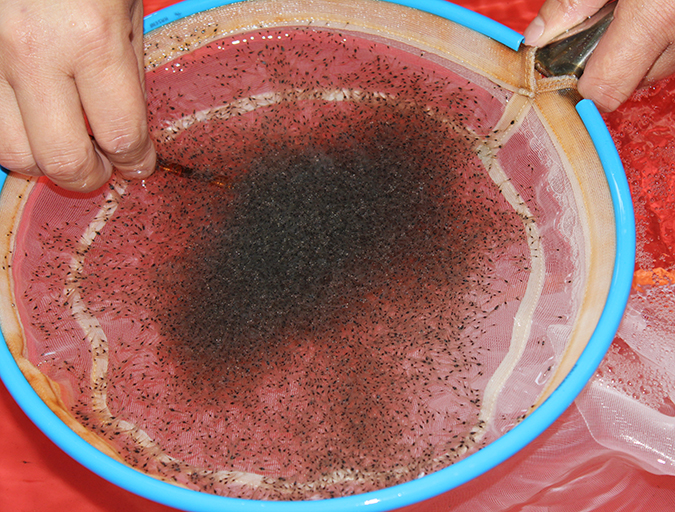
Health & Welfare
Acclimating shrimp postlarvae before pond stocking
Shrimp postlarvae acclimation before stocking into the various growout systems (ponds, raceways, tanks) is a critical – and often overlooked, sometimes taken for granted – step in the shrimp culture process. Various water quality parameters should be changed slowly so that the young shrimp have the time to gradually adapt to the new conditions.

Health & Welfare
A holistic management approach to EMS
Early Mortality Syndrome has devastated farmed shrimp in Asia and Latin America. With better understanding of the pathogen and the development and improvement of novel strategies, shrimp farmers are now able to better manage the disease.
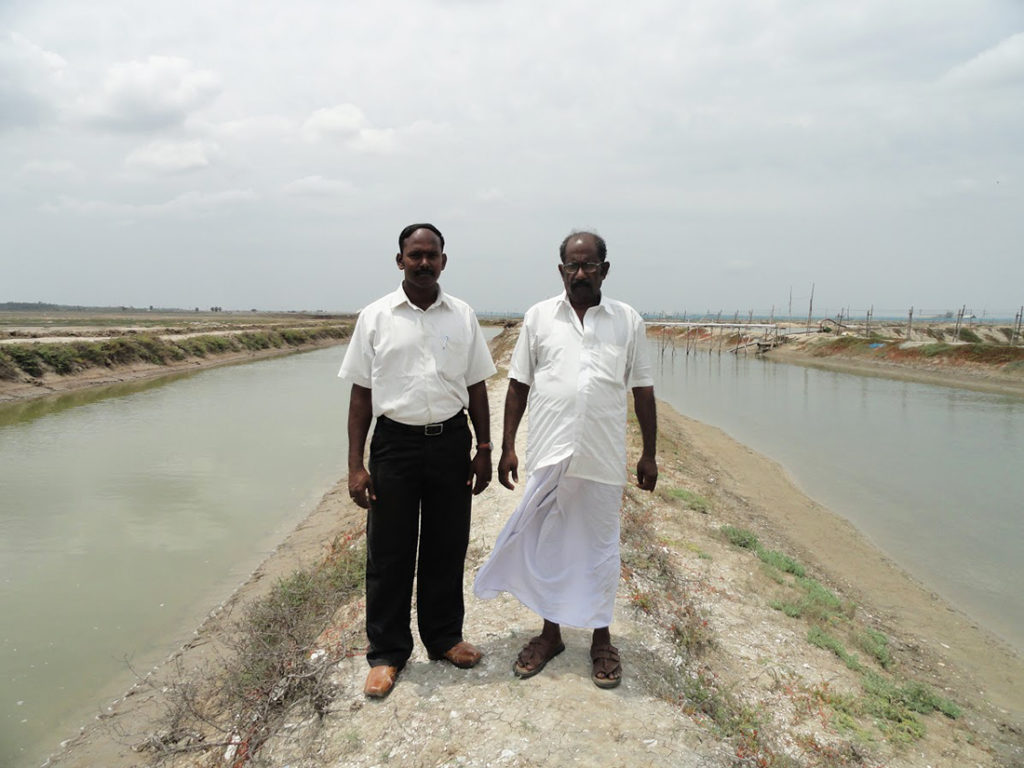
Responsibility
Improving shrimp farm design in flood-prone areas of India
Shrimp farm design improvements like reservoirs and recirculation canals can help small-scale shrimp farmers protect their infrastructure and improve production in flood-prone areas of India and elsewhere.


